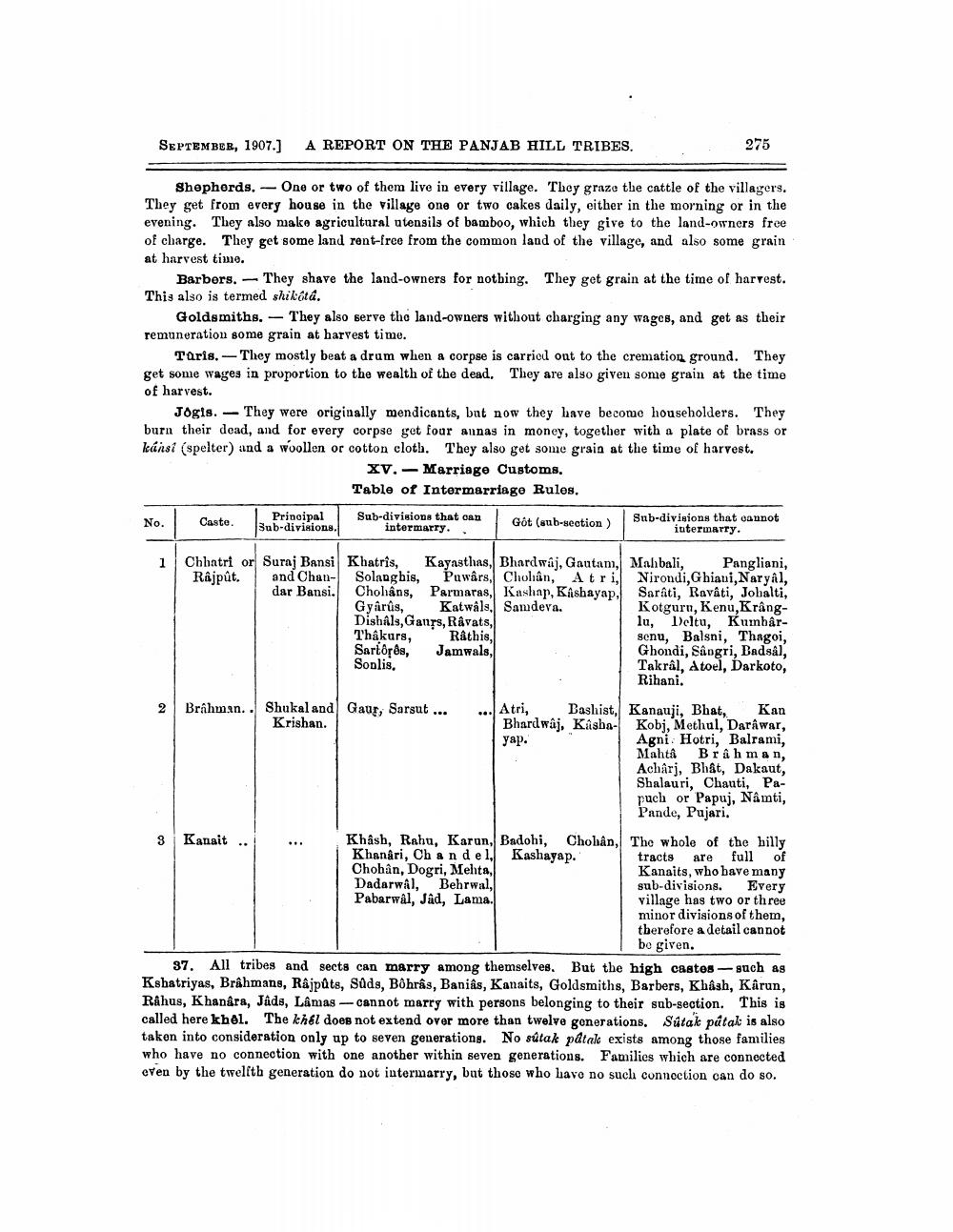________________
SEPTEMBER, 1907.]
Shepherds. One or two of them live in every village. They graze the cattle of the villagers. They get from every house in the village one or two cakes daily, either in the morning or in the evening. They also make agricultural utensils of bamboo, which they give to the land-owners free of charge. They get some land rent-free from the common land of the village, and also some grain at harvest time.
They shave the land-owners for nothing. They get grain at the time of harvest. This also is termed shikótá.
Barbers.
Goldsmiths. They also serve the land-owners without charging any wages, and get as their remuneration some grain at harvest time.
Taris. They mostly beat a drum when a corpse is carried out to the cremation ground. They get some wages in proportion to the wealth of the dead. They are also given some grain at the time of harvest.
No.
Jogis. They were originally mendicants, but now they have become householders. They burn their dead, and for every corpse get four annas in money, together with a plate of brass or kansi (spelter) and a woollen or cotton cloth. They also get some grain at the time of harvest.
XV. Marriage Customs. Table of Intermarriage Rules. Sub-divisions that can intermarry. Gôt (sub-section)
A REPORT ON THE PANJAB HILL TRIBES.
2
---
3
Caste.
1 Chhatri or Suraj Bansi Rajpût. and Chan
dar Bansi.
Principal Sub-divisions.
Kanait
275
Khatris, Kayasthas, Bhardwaj, Gautam, Solanghis, Puwârs, Cholân, Atri, Cholans, Parmaras, Kashap, Kashayap, Gyárûs, Katwals, Samdeva. Dishals, Gaurs, Râvats, Thakurs, Rathis, Sartores, Jamwals, Sonlis.
Brahman. Shukal and Gaur, Sarsut... Krishan.
Atri, Bashist, Bhardwaj, Kashayap.
Khâsh, Rahu, Karun, Badohi, Chohân, Khanâri, Ch a n del, Kashayap. Chohân, Dogri, Mehta,
Dadarwal, Behrwal, Pabarwal, Jâd, Lama.
Sub-divisions that cannot intermarry.
Mahbali, Pangliani, Nirondi,Ghiani, Naryal, Sarâti, Ravâti, Johalti, Kotguru, Kenu,Krânglu, Deltu, Kumbarsenu, Balsni, Thagoi, Ghondi, Sangri, Badsâl, Takrâl, Atoel, Darkoto, Rihani.
Kan
Kanauji, Bhat, Kobj, Methul, Darâwar, Agni Hotri, Balrami, Mahta Brahman, Achârj, Bhât, Dakaut, Shalauri, Chauti, Papuch or Papuj, Nâmti, Pande, Pujari.
The whole of the hilly tracts are full of Kanaits, who have many sub-divisions. Every village has two or three minor divisions of them, therefore a detail cannot be given.
37. All tribes and sects can marry among themselves. But the high castes-such as Kshatriyas, Brahmans, Râjpûts, Sûds, Bôhrâs, Baniâs, Kanaits, Goldsmiths, Barbers, Khâsh, Kârun, Râhus, Khanâra, Jâds, Lâmas-cannot marry with persons belonging to their sub-section. This is called here khel. The khel does not extend over more than twelve generations. Sútak patak is also taken into consideration only up to seven generations. No sûtak patak exists among those families who have no connection with one another within seven generations. Families which are connected even by the twelfth generation do not intermarry, but those who have no such connection can do so.




